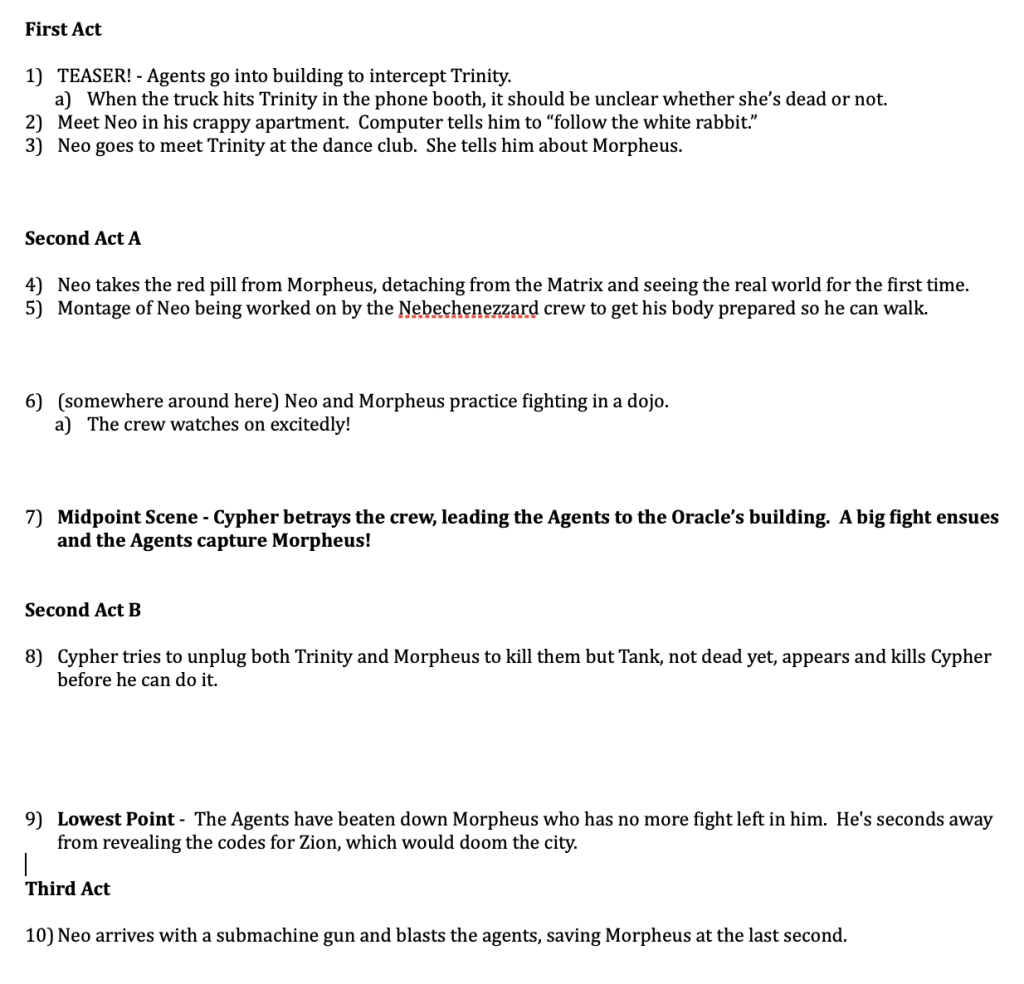You’ve been dreading it.
That word.
That evil enemy of all screenwriters.
The seven-letter word that may as well be the seven circles of Hell.
I’m talking about the…
Outline.
Look, I’m not going to debate you on whether it’s good to outline or not. For this script, you’re going to outline. And the good news is, it’s not going to be some elaborate ordeal. All you’re doing is taking everything that you’ve already written down and organizing it into a slightly more structured document.
A script is roughly 50 scenes. That’s assuming it’s 100 pages long with an average of 2 pages per scene. You might be writing longer scenes, like Quentin Tarantino does. That’s fine. You can easily calculate how many scenes you’ll write if your scenes average 5 pages per scene. 20 scenes.
The reason this is a nice number to know is that, now, when you lay out your outline, you can number the scenes and know how many scenes you’ve already imagined and how many you have left. Also, you’ll know where you’re missing scenes. You might have a bunch of scenes packed up in the first act and very few scenes after that. That should be an indication you need to add a few more scenes later on.
We want to make this outlining as simple as possible so here’s what I’d recommend doing. Divide it into four sections (First Act, Second Act A, Second Act B, Third Act). Each section will consist of 8-14 scenes depending on your writing style and the type of movie you’re writing. If you’re writing like Tarantino, closer to 8. If you’re writing like Michael Bay, closer to 14. Then, just start putting the scenes down chronologically and numbering them.
Since time is tight, all I care about is getting the bare essence down in the outline. But if you want to give yourself notes or write down some dialogue you had for the scene, by all means, go for it. You already have four scenes, since all of you did the checkpoints exercise. So put those in first. Then start filling in everything else.
By the way, I know that for some people, it’s confusing what constitutes a scene. If a couple is having an argument in their living room, then one of the characters storms upstairs, the other follows, and now they argue in the bedroom, does that constitute one scene or two? Generally speaking, if there’s a location change, it’s a new scene. But if the scenario naturally flows from one location to another, you can easily count it as one scene. Sometimes it’s up to the writer to decide. Kind of how it can be arbitrary where to break and start a new paragraph in a novel. I would constitute the above character argument as one scene. But if there was a small pause where both characters caught their breath in the middle, you could easily argue that it would be two scenes. The point is, don’t get too caught up in all that. What matters is we get as many scenes into the outline at possible.
Here’s a general idea of what you should be going for…
As you can see, I’ve got 10 scenes figured out for a script I’m working on called “The Matrix.” Doing the math, that’s roughly 20-30 pages worth of scenes. Which gives me a good indication of how many more scenes/pages I need to get my full 100-110 page screenplay. Notice I’m leaving space between areas where I don’t know what’s going to happen yet. That’s so I have a visual indication of where I need to fill stuff in.
Just to be clear, don’t worry if you don’t have everything figured out yet. A big part of writing is discovering things along the way. So you’ll get new ideas as you’re writing Monday, Tuesday, and Wednesday, which will help you start filling in some of the thinner sections of your outline as you go. And, of course, if you don’t jive with this outlining method, feel free to use your own. Just remember that we’re all trying to do something different this time around to see if there’s a better approach than what we’ve been using in the past. So I encourage you to give this a shot.
Wow, six days later and we’re ready to start writing!
I’ll begin the official WRITE A SCREENPLAY IN 2 WEEKS posts Sunday night at 11pm Pacific time. That’s where I’ll tell you, specifically, how you’re going to approach this to easily finish a screenplay in two weeks.
Seeya then!



